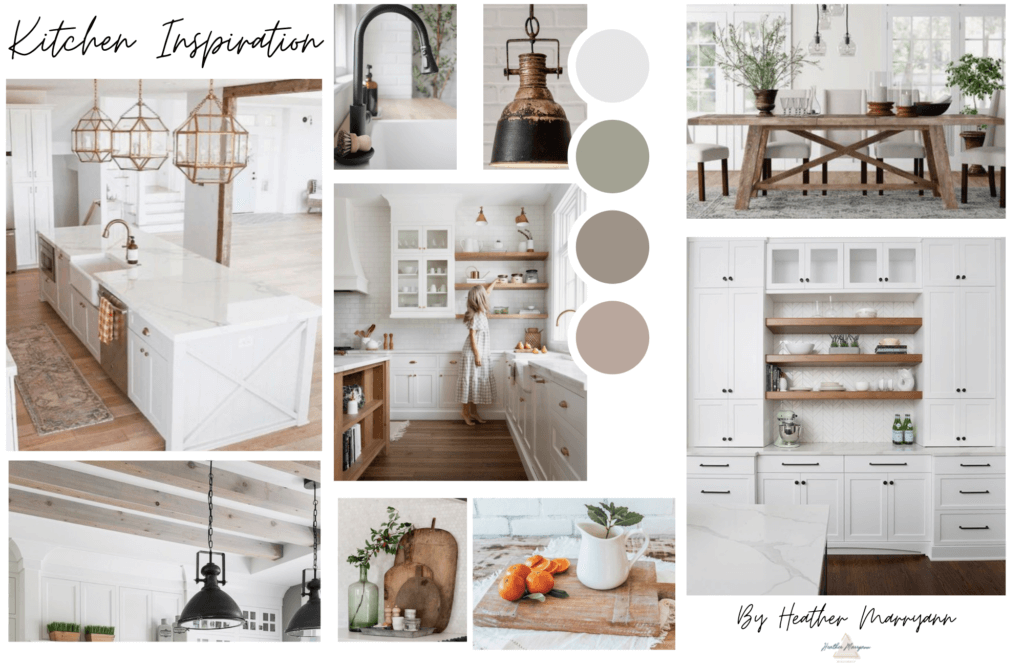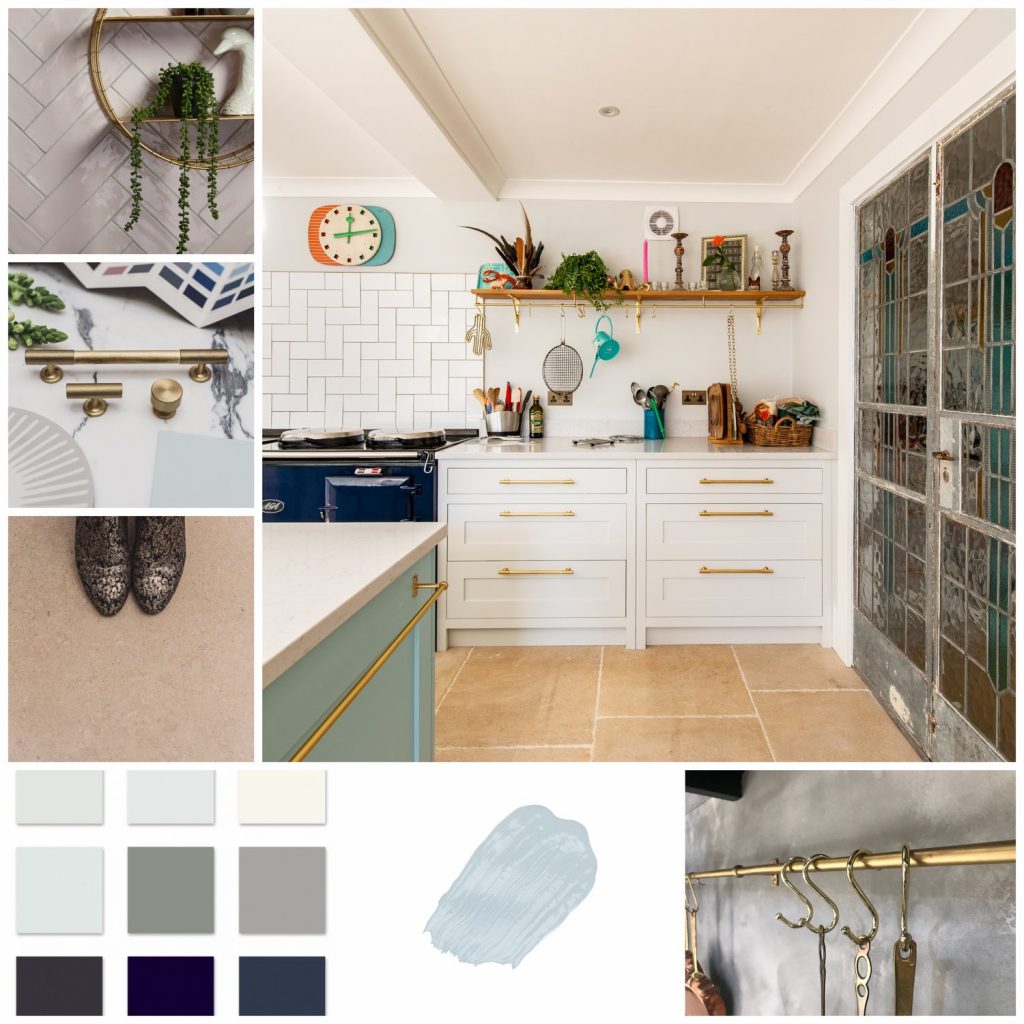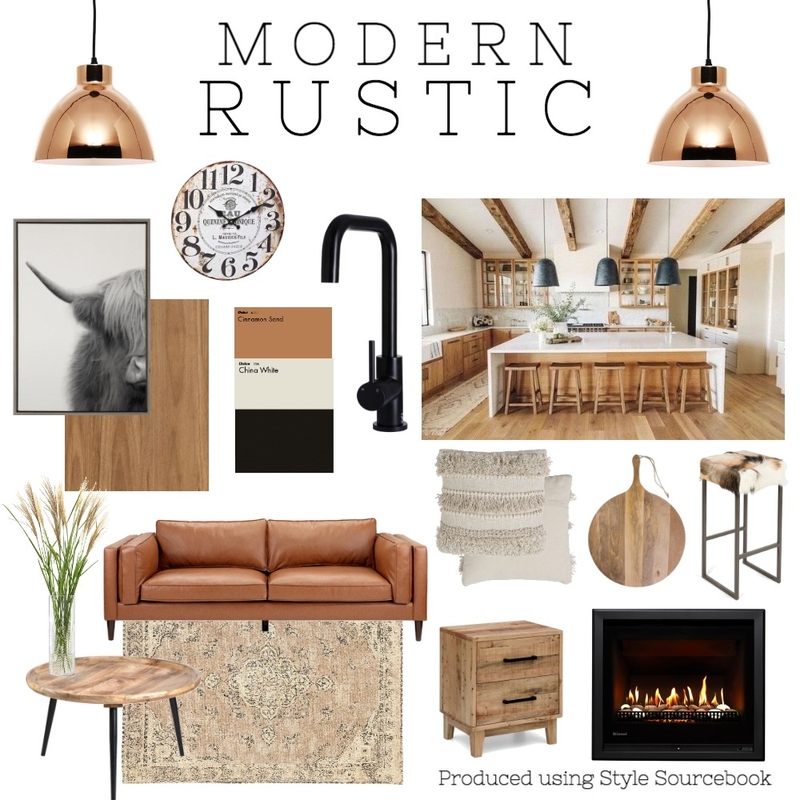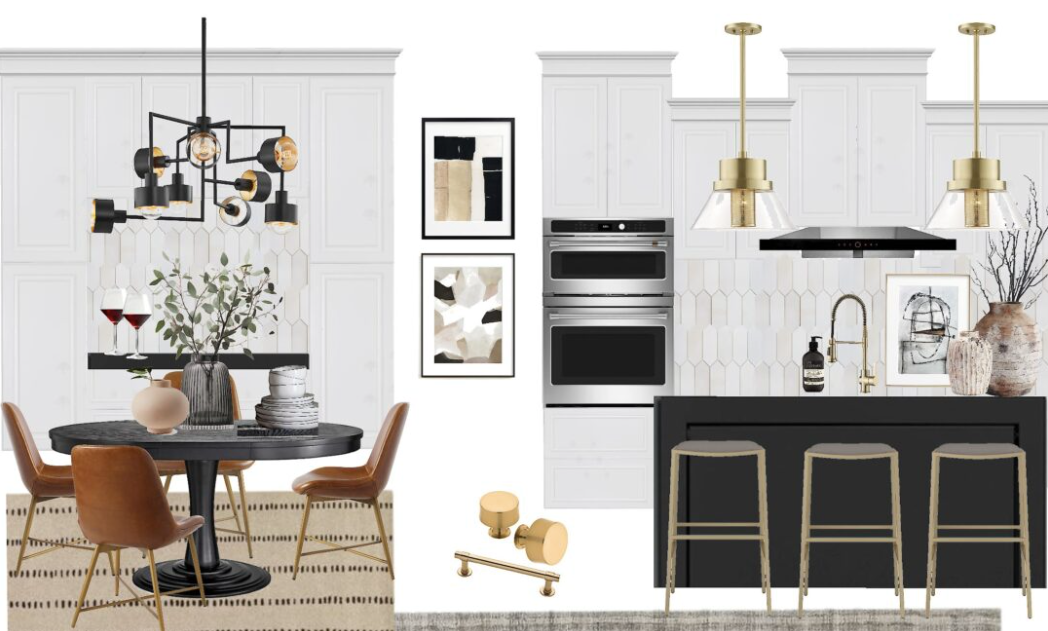Kitchen & Living Room Bliss: Mood Board Magic
Kitchen & Living Room Bliss: Mood Board Magic
The heart of a home is often found in the kitchen and living room. These spaces are where we cook, eat, relax, socialize, and create memories. But with so much going on, achieving a harmonious and cohesive design can feel daunting. Enter the mood board, a powerful tool that can transform your vision from hazy dreams to a tangible roadmap for your dream kitchen and living room.

What is a Mood Board?
In essence, a mood board is a visual representation of your design aesthetic for a particular space. It's a curated collection of images, textures, colors, and even materials that inspire your design choices. Imagine it as a visual story that whispers your desires and aspirations for your kitchen and living room.
Why Create a Mood Board?

Creating a mood board for your kitchen and living room offers numerous benefits:
- Clarity and Direction: A mood board helps you define your style and create a cohesive design direction. Instead of feeling overwhelmed by countless choices, you'll have a clear visual guide to follow.
- Inspiration and Exploration: The process of creating a mood board encourages you to explore different styles, materials, and colors. This exploration sparks creativity and helps you discover hidden gems you might not have considered.
- Communication and Collaboration: A mood board serves as a visual language that allows you to communicate your design vision to contractors, designers, or even family members. It provides a shared understanding and eliminates misunderstandings.
- Budget and Planning: By assembling your mood board, you gain a clearer picture of the costs involved. You can compare different options and adjust your budget accordingly.
Building Your Kitchen & Living Room Mood Board: A Step-by-Step Guide

Now that you're convinced of the mood board's magic, let's dive into the steps to create your own:
Step 1: Define Your Style
- Think about the overall vibe you want to create: Do you envision a cozy and inviting space, a modern and sleek haven, a rustic and charming retreat, or a vibrant and eclectic sanctuary?
- Reflect on your lifestyle: How do you envision using these spaces? Do you enjoy cooking elaborate meals or prefer quick and simple snacks? Are you a bookworm who needs a dedicated reading nook, or do you prioritize entertaining guests?
- Consider your personal preferences: What colors, textures, and patterns resonate with you? Do you gravitate towards natural elements or prefer a more minimalist aesthetic?

Step 2: Gather Inspiration
- Browse online resources: Websites like Pinterest, Houzz, and Instagram are treasure troves of inspiration. Create dedicated boards and pin images that resonate with your style.
- Explore magazines and design books: Magazines like Architectural Digest, Elle Decor, and Dwell offer stunning photography and design ideas.
- Visit showrooms and stores: Experiencing materials and finishes in person can give you a deeper understanding of your preferences.
Step 3: Organize Your Inspiration

- Digital Mood Board: Create a digital mood board using platforms like Pinterest, Canva, or even a simple online document.
- Physical Mood Board: Assemble a physical mood board using a cork board, foam board, or even a large piece of paper. You can use pins, tape, or glue to attach your inspiration.
- Mix and Match: Don't feel limited to a single format. You can use both digital and physical tools to capture your vision.
Step 4: Curate Your Collection
- Focus on the big picture: Include images that showcase the overall style, color palette, and architectural elements you desire.
- Don't forget the details: Add images of furniture, fixtures, lighting, artwork, and even textiles to bring your vision to life.
- Incorporate texture and color: Add swatches of fabrics, paint chips, or samples of materials to create a multi-sensory experience.

Step 5: Fine-Tune Your Vision
- Review and refine: As you gather inspiration, periodically review your mood board and make adjustments as needed. Eliminate any images that don't align with your overall vision.
- Ask for feedback: Share your mood board with trusted friends, family members, or a design professional for their input.
- Refine your style: As you gather feedback and refine your mood board, your style may evolve. Embrace this process as an opportunity to create a space that truly reflects your personal taste.
Mood Board Ideas for Kitchen & Living Room Inspiration

Now, let's get your creative juices flowing with specific mood board ideas for your kitchen and living room:
Kitchen Mood Board Ideas:
- Modern Farmhouse: Combine rustic elements like reclaimed wood with modern finishes like stainless steel appliances and sleek cabinetry.
- Coastal Chic: Embrace a light and airy feel with whitewashed cabinets, natural textures like seagrass, and pops of blue and green.
- Industrial Chic: Incorporate exposed brick, metal accents, and vintage industrial lighting for a raw and edgy aesthetic.
- Minimalist Zen: Create a calming sanctuary with clean lines, neutral colors, and natural materials like bamboo and stone.
- Rustic Retreat: Embrace the warmth of wood and stone, incorporate vintage finds, and add a touch of farmhouse charm with woven baskets and natural textiles.

Living Room Mood Board Ideas:
- Mid-Century Modern: Embrace iconic furniture pieces, warm wood tones, and pops of color like mustard yellow and turquoise.
- Bohemian Chic: Layer textures, patterns, and colors for a vibrant and eclectic space. Embrace global influences and incorporate vintage finds.
- Scandinavian Minimalism: Keep the color palette simple and focus on natural materials like wood, wool, and leather. Incorporate cozy textiles and soft lighting.
- Glamorous Hollywood Regency: Embrace metallic accents, luxurious velvet furniture, and dramatic lighting. Don't be afraid to add a touch of sparkle!
- Contemporary Classic: Create a timeless space with clean lines, neutral colors, and high-quality materials. Incorporate statement pieces like a sculptural coffee table or a vintage rug.
Using Your Mood Board for Success:

- Showcase your Vision: Share your mood board with contractors, designers, or anyone else involved in your project to ensure everyone is on the same page.
- Make Informed Decisions: Use your mood board as a guide when making specific design choices, like selecting furniture, lighting, or finishes.
- Remain Flexible: While a mood board provides direction, remember to be open to adjustments and changes as the project progresses.
Conclusion: Unleash the Magic of Mood Boards
Creating a mood board is not simply a design exercise; it's a journey of self-discovery and creative expression. It allows you to translate your vision into a tangible representation of your dream kitchen and living room. By taking the time to curate your mood board, you'll embark on a path towards creating spaces that are both functional and beautiful, spaces that reflect your unique personality and inspire countless happy moments.
.jpg)
So, gather your inspiration, unleash your creativity, and let the mood board magic transform your kitchen and living room into a true haven.
Dream Kitchen & Living Room: One Mood Board, Two Wow Factors
In the heart of your home, where culinary magic meets cozy gatherings, the kitchen and living room often intertwine. This dynamic duo begs for a harmonious blend of functionality and aesthetics, a delicate dance between cooking and socializing. A mood board can be your compass, guiding you towards a design that truly reflects your style and lifestyle.
This article will delve into the art of creating a dream kitchen and living room mood board, exploring the essential elements, practical tips, and inspirational ideas to spark your imagination. Whether you're embarking on a complete renovation or simply seeking a refresh, this comprehensive guide will empower you to create a space that seamlessly blends functionality and style.
The Power of a Mood Board: Visualizing Your Vision
A mood board is more than just a collection of pretty pictures. It's a visual blueprint, a tangible expression of your design aspirations. By bringing together images, swatches, textures, and even actual objects, you create a cohesive narrative that speaks volumes about your taste and preferences.
Here's how a mood board can elevate your kitchen and living room design:
- Visual Inspiration: Mood boards provide a powerful visual reference, showcasing the overall aesthetic you're aiming for. They translate your abstract ideas into tangible visual cues, making it easier to envision the finished product.
- Unified Vision: By combining various elements like furniture, color palettes, and materials, a mood board helps ensure coherence and consistency throughout the space. This prevents design clashes and fosters a sense of unity.
- Clear Communication: Whether you're collaborating with a designer or tackling the project yourself, a mood board serves as a clear visual communication tool. It facilitates productive discussions and ensures everyone is on the same page.
- Streamlined Decision-Making: Facing a dizzying array of options can be overwhelming. A mood board helps you narrow down choices, eliminate distractions, and focus on elements that truly resonate with your vision.
- Personalized Expression: Mood boards are a unique reflection of your personality and style. They allow you to express your individual aesthetic preferences and create a space that truly feels like home.
Building Your Dream Kitchen & Living Room Mood Board
Creating a compelling mood board requires thoughtful planning and a systematic approach. Here's a step-by-step guide to help you navigate the process:

1. Define Your Design Goals
Before diving into the visual elements, take some time to articulate your design goals. Consider the following questions:
- What is the primary function of the space? Is it a space for cooking, entertaining, relaxing, or a combination of all three?
- What are your lifestyle needs? Do you frequently host large gatherings, prefer intimate dinners, or work from home?
- What is your personal style? Do you lean towards modern, rustic, minimalist, traditional, or eclectic aesthetics?
- What is your budget? Knowing your budget will help you prioritize and make realistic choices.
- What are your must-have features? Are there specific appliances, furniture pieces, or design elements that are non-negotiable?

2. Gather Visual Inspiration
Once you have a clear understanding of your goals, start collecting visual inspiration. Explore various sources for images, textures, and samples:
- Pinterest: A treasure trove of kitchen and living room design ideas, Pinterest allows you to create mood boards directly within the platform.
- Houzz: Explore countless real-life home design projects, browse thousands of products, and connect with professionals.
- Instagram: Discover design trends and captivating interiors showcased by interior designers, architects, and home decor enthusiasts.
- Design Magazines & Websites: Publications like Architectural Digest, Elle Decor, and Dwell offer curated inspiration and insightful articles on design trends.
- Home Décor Stores: Visit local home décor stores to browse furniture, fabrics, lighting, and accessories. You can collect swatches, brochures, and even purchase small items to incorporate into your mood board.

3. Choose a Medium
You have several options for creating your mood board:
- Digital Mood Boards: Utilize online platforms like Pinterest, Canva, or Milanote to create digital mood boards. These platforms allow you to easily arrange images, add text, and share your boards with others.
- Physical Mood Boards: For a more hands-on approach, use a corkboard, foam board, or even a large sheet of paper to create a physical mood board. This allows you to physically arrange and rearrange elements, experience textures, and feel the overall vibe of your design.

4. Curate Your Elements
Now it's time to start curating your elements, ensuring a cohesive and captivating narrative:
- Colors & Textures: Choose a color palette that reflects your personal style and complements the existing architecture. Incorporate various textures to create depth and visual interest. Consider using swatches, fabric samples, and even actual objects like wood, stone, or tile to represent different textures.
- Furniture & Lighting: Include images of furniture pieces that fit your style and functionality needs. Explore lighting options that enhance the ambiance and complement the overall aesthetic.
- Materials & Finishes: Research materials and finishes for countertops, cabinetry, flooring, and backsplashes. Include images or samples to visualize their impact on the overall design.
- Décor & Accessories: Add images of decorative elements like artwork, rugs, throws, and plants to enhance the personality and style of the space.
- Inspiration Quotes: Include inspirational quotes that reflect your vision and create a sense of intentionality.

5. Arrange and Refine
Once you've gathered your elements, start arranging them on your chosen medium. Experiment with different layouts, exploring the flow and balance of your design. Refine your choices, removing any elements that don't resonate with your overall vision.
Design Tips for Your Kitchen & Living Room

As you curate your mood board, keep these design tips in mind to create a space that is both functional and beautiful:
- Open Concept Flow: Consider creating an open concept layout to visually connect the kitchen and living room. This allows for seamless flow and fosters a sense of spaciousness.
- Kitchen Island as a Focal Point: A kitchen island serves as a central hub for both cooking and socializing. It can also act as a natural dividing line between the kitchen and living room, creating a sense of distinct zones while maintaining a unified feel.
- Seating & Functionality: Strategically place seating options in the living room, ensuring comfortable flow and facilitating conversations. Consider incorporating bar stools at the kitchen island to create a seamless transition between the two areas.
- Color Harmony & Contrast: Create a harmonious color palette that flows between the kitchen and living room. Consider using contrasting colors for accents, such as a bold countertop in the kitchen or a vibrant rug in the living room, to add visual interest and define spaces.
- Natural Light & Ventilation: Maximize natural light by incorporating large windows and strategically placing skylights. Ensure adequate ventilation, especially in the kitchen, to prevent odors and maintain a comfortable environment.
- Ergonomics & Functionality: Pay attention to ergonomics and functionality, ensuring ease of movement and convenient access to appliances, storage, and seating.
Examples of Mood Boards for Kitchen & Living Room

To further inspire your creativity, let's explore some examples of mood boards for different design styles:
1. Modern Minimalist
- Color Palette: White, gray, black with pops of metallic accents
- Materials & Finishes: Sleek countertops (quartz, marble), stainless steel appliances, wood flooring
- Furniture: Clean-lined sofas, minimalist armchairs, modern dining table with transparent chairs
- Lighting: Pendant lights with geometric shapes, recessed lighting
- Décor: Minimalist artwork, abstract sculptures, potted plants

2. Rustic Farmhouse
- Color Palette: Warm neutrals (cream, beige, gray), with accents of wood tones and earthy greens
- Materials & Finishes: Reclaimed wood, exposed brick, natural stone, farmhouse sink
- Furniture: Overstuffed sofas, distressed wood coffee tables, rustic dining table with farmhouse chairs
- Lighting: Chandeliers with rustic elements, lanterns
- Décor: Rustic artwork, vintage rugs, woven baskets, potted herbs
3. Contemporary Chic

- Color Palette: Bold colors (navy, emerald green, mustard yellow) combined with neutral tones (gray, white, black)
- Materials & Finishes: Polished concrete, metallic accents, glass, leather
- Furniture: Velvet sofas, sleek armchairs, modern dining table with geometric chairs
- Lighting: Statement pendant lights, track lighting
- Décor: Sculptural artwork, geometric patterns, patterned throw pillows
Conclusion: A Dream Kitchen & Living Room Awaits
Creating a mood board for your kitchen and living room is the first step towards transforming your vision into reality. It's a powerful tool that empowers you to visualize your dream space, communicate your design goals effectively, and make informed choices throughout the design process.
.jpg)
As you embark on your journey, remember to embrace your unique style and let your personality shine through in every element. With thoughtful planning, a touch of creativity, and a bit of inspiration, you can create a kitchen and living room that is both functional and beautiful, a space that truly reflects your lifestyle and becomes the heart of your home. .

